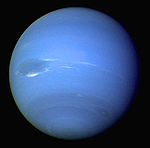- Neptune trojan
-
Types of Distant Minor Planets - Cis-Neptunian objects
- Centaurs
- Neptune trojans
- Trans-Neptunian objects (TNOs)‡
- Kuiper belt objects (KBOs)
- Classical KBOs (Cubewanos)
- Resonant KBOs
- Plutinos (2:3 Resonance)
- Scattered disc objects (SDOs)
- Detached objects
- Oort cloud objects (OCOs)
- Kuiper belt objects (KBOs)
‡ Trans–Neptunian dwarf planets are "plutoids" Neptune trojans (named by analogy to Jupiter's Trojan asteroids) are Kuiper belt object-like bodies in solar orbit that have the same orbital period as Neptune and follow roughly the same orbital path.[1] Six of the eight found so far lie in the elongated, curved region around the Sun–Neptune L4 Lagrangian point 60° ahead of Neptune.
 This animation shows the path of the 6 L4 Neptune trojans in a rotating frame with a period equal to Neptune's orbital period. (Neptune is held stationary.)
This animation shows the path of the 6 L4 Neptune trojans in a rotating frame with a period equal to Neptune's orbital period. (Neptune is held stationary.)
The discovery of 2005 TN53 in a high-inclination (>25°) orbit was significant as it suggested a “thick” cloud of trojans[2] (Jupiter trojans have inclinations up to 40°[3]). It is believed that large (radius ≈ 100 km) Neptune trojans could outnumber Jupiter trojans by an order of magnitude.[4][5]
Both 2005 TN74[6] and 2007 RW10 were believed to be Neptune trojans when first discovered, but were later reclassified.
On August 12, 2010, the Minor Planet Center announced the discovery of the first known L5 Neptune trojan, 2008 LC18.[7] Neptune's trailing L5 region is currently very difficult to observe because it is along the line-of-sight to the center of our galaxy, an area of the sky crowded with stars.
It may be possible for the New Horizons spacecraft to investigate L5 Neptune trojans discovered by 2014, when it passes through this region of space en route to Pluto.[5]
Contents
Neptune trojan objects
As of July 2011, eight Neptune trojan objects are known. This table is constructed from information obtained from the List Of Neptune Trojans maintained by the IAU Minor Planet Center[1] and with diameters from Sheppard and Trujillo's paper on 2008 LC18.[8]
Provisional
DesignationLagrangian
PointPerihelion
(AU)Aphelion
(AU)Inclination
(°)Absolute
magnitudeDiameter
(km)Discovery
yearReference 2001 QR322 L4 29.428 31.349 1.3 8.2 ~140 2001 2004 UP10 L4 29.351 31.259 1.4 8.8 ~100 2004 2005 TN53 L4 28.253 32.284 25.0 9.1 ~80 2005 [2] 2005 TO74 L4 28.733 31.824 5.2 8.5 ~100 2005 2006 RJ103 L4 29.345 31.005 8.2 7.5 ~180 2006 2007 VL305 L4 28.131 32.171 28.1 8.0 ~160 2007 2008 LC18 L5 27.547 32.468 27.5 8.4 ~100 2008 [8] 2004 KV18 L5 24.589 35.662 13.6 8.9 56[9] 2011 [10] See also
Notes and references
- ^ a b "List Of Neptune Trojans". Minor Planet Center. http://www.minorplanetcenter.org/iau/lists/NeptuneTrojans.html. Retrieved 2011-07-28.
- ^ a b Sheppard, Scott S.; Trujillo, Chadwick A. (June 2006). "A Thick Cloud of Neptune Trojans and Their Colors" (PDF). Science 313 (5786): 511–514. Bibcode 2006Sci...313..511S. doi:10.1126/science.1127173. PMID 16778021. http://www.dtm.ciw.edu/users/sheppard/pub/Sheppard06NepTroj.pdf. Retrieved 2008-02-26.
- ^ Jewitt, David C.; Trujillo, Chadwick A.; Luu, Jane X. (2000). "Population and size distribution of small Jovian Trojan asteroids". The Astronomical journal 120 (2): 1140–7. arXiv:astro-ph/0004117. Bibcode 2000AJ....120.1140J. doi:10.1086/301453.
- ^ E. I. Chiang and Y. Lithwick Neptune Trojans as a Testbed for Planet Formation, The Astrophysical Journal, 628, pp. 520–532 Preprint
- ^ a b David Powell (30 January 2007). "Neptune May Have Thousands of Escorts". Space.com. http://www.space.com/scienceastronomy/070130_st_neptune_trojans.html. Retrieved 2007-03-08.
- ^ 2005 TN74, listed earlier as a Neptune trojan, is likely to be a Trans-Neptunian object (TNO) in a 3:5 resonance with Neptune.
- ^ Scott S. Sheppard (2010-08-12). "Trojan Asteroid Found in Neptune's Trailing Gravitational Stability Zone". Carnegie Institution of Washington. http://www.dtm.ciw.edu/users/sheppard/L5trojan/. Retrieved 2007-12-28.
- ^ a b Sheppard, Scott S.; Trujillo, Chadwick A. (2010-08-12). "Detection of a Trailing (L5) Neptune Trojan". Science (AAAS) 329 (5997): 1304. Bibcode 2010Sci...329.1304S. doi:10.1126/science.1189666. PMID 20705814. http://www.sciencemag.org/cgi/content/abstract/science.1189666. Retrieved 2010-08-13.
- ^ The Tracking News
- ^ "JPL Small-Body Database Browser: 2004 KV18". http://ssd.jpl.nasa.gov/sbdb.cgi?sstr=2008LC18. Retrieved 2011-08-08.
External links
- Planetary Trojans – the main source of short period comets? (arXiv:1007.2541 : 15 Jul 2010)
Small Solar System bodies Minor planets - Designation
- Groups
- Moons
- Meanings of names
- Pronunciation of names
- Centaurs
- Damocloids
- Neptune trojans
- Trans-Neptunian objects
- (Detached
- Kuiper belt
- Oort cloud
- Scattered disc)
Comets Meteoroids Lists / categories - Asteroid groups and families
- Asteroid moons
- Binary asteroids
- Minor planets
Neptune Discovery 
Characteristics - Rings
- Great Dark Spot
- Small Dark Spot
- The Scooter
- Kuiper belt
Moons Exploration Trojans Miscellaneous Categories:- Distant minor planets
- Neptune Trojans
- Lists of asteroids
- Cis-Neptunian objects
Wikimedia Foundation. 2010.

